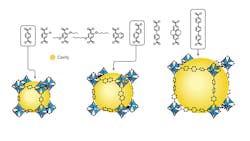Nobel Prize in Chemistry Honors Inventors of Metal-Organic Frameworks
Three scientists received the 2025 Nobel Prize in Chemistry for developing metal-organic frameworks, porous materials that show potential for addressing environmental issues, including PFAS mitigation.
The Royal Swedish Academy of Sciences awarded the prize Oct. 8 to Susumu Kitagawa, Richard Robson and Omar Yaghi. Metal-organic frameworks, or MOFs, are characterized by metal ions and molecules organized to form crystals that contain large cavities.
Chemists can alter the building blocks used in MOFs to capture and store specific substances, drive chemical reactions or conduct electricity.
“Metal–organic frameworks have enormous potential, bringing previously unforeseen opportunities for custom-made materials with new functions,” said Heiner Linke, chair of the Nobel Committee for Chemistry.
From Unstable Beginnings to Environmental Promise
Robson, a professor of chemistry at the University of Melbourne in Australia, began his work on MOFs in 1989 when he combined positively charged copper ions with a four-armed molecule that created a well-ordered crystal filled with cavities.
The molecular construction showed potential but was unstable and collapsed easily. Over the next decade, Kitagawa and Yaghi made several discoveries that resulted in a more stable design.
Kitagawa, a distinguished professor at Kyoto University in Japan, showed that gases can flow in and out of the constructions and predicted that MOFs could be made flexible. Meanwhile, Yaghi, a professor of chemistry at the University of California Berkeley, created a stable MOF and showed that it can be modified using rational design, giving it new and desirable properties.
Yaghi eventually coined the term “metal-organic frameworks” in a Nature article, according to the Royal Swedish Academy of Sciences.
Since their discoveries, chemists have built tens of thousands of different MOFs.
Potential future applications for MOFs include separating PFAS from water, breaking down traces of pharmaceuticals in the environment, capturing carbon dioxide or harvesting water from desert air.
In 2023, BASF announced that it had developed scaled MOFs for use in carbon-capture and removal. At the time, the company said it had begun working to synthesize MOFs in the early 2000s with the help of Yaghi.
Also, in 2022, researchers at the University of Toronto and Northwestern University used machine learning and artificial intelligence to craft the best building blocks in the assembly of MOFs so they target specific applications.
About the Author
Jonathan Katz
Executive Editor
Jonathan Katz, executive editor, brings nearly two decades of experience as a B2B journalist to Chemical Processing magazine. He has expertise on a wide range of industrial topics. Jon previously served as the managing editor for IndustryWeek magazine and, most recently, as a freelance writer specializing in content marketing for the manufacturing sector.
His knowledge areas include industrial safety, environmental compliance/sustainability, lean manufacturing/continuous improvement, Industry 4.0/automation and many other topics of interest to the Chemical Processing audience.
When he’s not working, Jon enjoys fishing, hiking and music, including a small but growing vinyl collection.
Jon resides in the Cleveland, Ohio, area.

